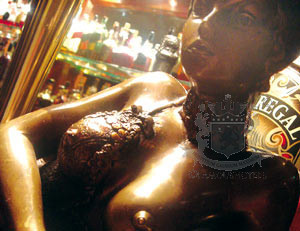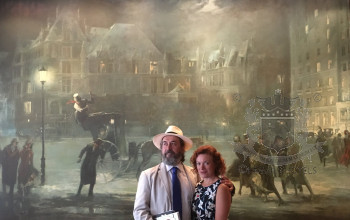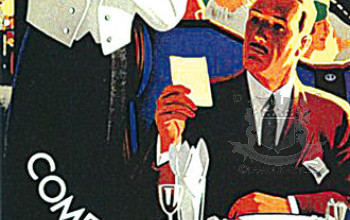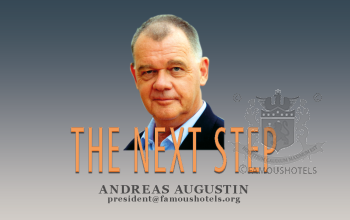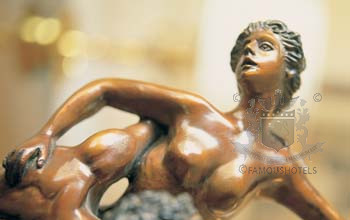Mourby of India
( words)
By Adrian Mourby, Contributing Editor
Before arriving at The Imperial in Delhi I’d read a wonderfully inaccurate entry in an Indian guide book. Evidently it was in a bar at The Imperial that Jawaharlal Nehru, Mahatama Gandhi, Muhammad Ali Jinnah and Lord Mountbatten agreed the partition of India and Pakistan.

Nehru - seated in the centre - listening, at the Imperial.
The mind boggled.
Sitting on my flight from Heathrow I found it hard to imagine the boys squeezing onto a banquette, Gandhi and Nehru with their orange juices, Jinnah sipping whisky, while Louis Mountbatten – G&T in hand – sketched out the details of the new border on the back of an envelope.
In fact the truth is much more dramatic but I only found this out at the end of my first very long day in Delhi. My wife and I had flown in that morning arriving painfully early in some painful seats. Thank heavens Bales Worldwide had arranged for us to be picked up and transported to the hotel. We would have been incapable of arranging our own transfers.
It took a while for our taxi to weave its way through the Lutyens-designed centre of New Delhi. Most of the Chinese governent were in town that day and their motorcades were ahead of us.
The Imperial itself turned out to be a surprisingly modern building for the oldest purpose-built hotel in India. It opened in 1936, a sequence of white Art deco courtyards with low, wide corridors connecting the bedrooms. On the first floor there was – unusually – a ballroom with terraces built over the verandas below. With its staff moving about quietly in their brocaded red jackets, the whole place felt timelessly calm.
 Adrian Mourby (left)
Adrian Mourby (left)
The Imperial Hotel was built by S.B.S. Ranjit Singh whose family still run it. The Singh family had been involved in some major construction projects during British rule. In fact R.B.S. Narain Singh, father of the hotel builder, had been responsible for the construction of the roads of New Delhi built for the great Durbar of December 1911. This new hotel was championed by the formidable Marie Freeman-Thomas, Marchioness of Willingdon, wife of the Viceroy, who saw it as an important missing element in Edwin Lutyens’ great plan for New Delhi. A location had been reserved for a hotel on Queensway (now known as Janpath).

Twenty-four king palm trees line the road to the hotel’s lofty porch.
The architect was Charles G. Blomfield, one of Edwin Lutyens’ assistants on the New Delhi project, who also built several houses in what is now known as the “Lutyens Bungalow District”. C.G. Blomfield and Mr Singh were to have a lot of dealings with Lady Willingdon who took a keen interest in the interior finish of the hotel. According to current General Manager Mr Vijay Wanchoo, the stock of two Italian marble merchants was entirely depleted during the hotel’s completion. It was Her Ladyship who decided on the name ‘Imperial’.
The Marchioness was concerned that the ladies of New Delhi didn't have somewhere suitable to meet socially and The Imperial offered an ideal solution. Sadly, the Willingdons did not stay long enough in Delhi to enjoy the hotel. In 18 April 1936 the Earl's five year term as Viceroy and Governor-General of India came to an end and he returned to the UK where he became a favourite tennis partner of George V. While The Imperial is in many way Lady Willingdon’s memorial, it’s worth noting that her husband is commemorated by the Willingdon Sports Club in Bombay. The Viceroy established this club (with membership open to both Indians and British) after being denied entry to the Royal Bombay Yacht Club because he was in the company of Indian friends.

The book IMPERIAL New Delhi by Andreas Augustin
Neither the 1911 Indian Restaurant nor Spice Route, a technicolour Southeast Asian restaurant illustrated with paintings by the Daniells - two British artists, uncle and nephew, who painted India in the nineteenth century - open for lunch. So we ate a very convincing Italian meal in the San Gemignano restaurant followed by an improvised tour of the hotel, its veranda, dining rooms, tea lounge and gardens.
Up a long flight of steps to the first floor I came upon the Royal Ballroom which is lined with mirrors and full-length French windows opening out onto a balcony. On one wall I found black and white photos of a great conference held here in 1947 with the unmistakable seated figures of Jawaharlal Nehru, Mahatma Gandhi, Muhammad Ali Jinnah and Lord Louis Mountbatten. This was the conference that decided the partition of India and Pakistan. The venue was chosen for its size, its security and no doubt because it lent dignity to some very important proceedings. Not by any stretcgh of the imagination could you call this a bar!
We did find one delightful bar however, a recent addition to the hotel called Patiala Peg. Situated off one of the courtyards it takes its name from the hugely wealthy Maharajah of Patiala. There is a connection with the hotel here because In the year 1880 R.B.S.Narain Singh (the father of the man who built the Imperial) was awarded a lucrative contract by the Maharajah to build part of the Patiala Tunnel in Punjab. But it is his son, the splendid Maharaja Bhupinder Singh (1891 – 1938) whose name is commemorated by this darkly panelled bar. Fabulously wealthy, the young Maharaja was renowned for his extravagance and his prowess on the cricket pitch. He also maintained a polo and cricket team that were considered among the best in India. On one occasion he arranged a tent-pegging game against an Irish regimental polo team and was so worried that his own team would lose, that he made sure the Irish visitors were given overgenerous measures of alcohol the night before their encounter. The Patiala team duly triumphed and in their honour all measures in the Patiala Peg bar are 75ml rather than standard 60ml.
This is certainly a fine bar but it’s not where history was made. That’s the ballroom upstairs. Now it all made sense.
Adrian Mourby is A Travelling Ambassador of The Most Famous Hotels in the World

